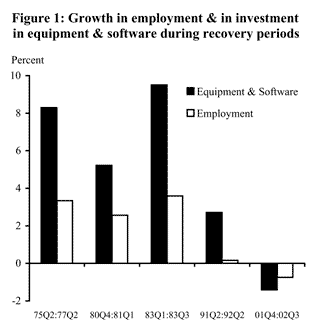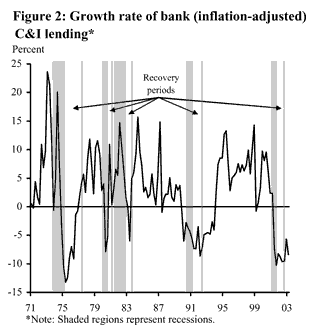Bank lending to businesses tends to be procyclical, contracting with an economic slowdown and rising with an expansion. However, throughout both the recent recovery from recession and the recovery after the early 1990s recession, the volume of commercial and industrial (C&I) loans actually continued to contract.
- Business lending over the business cycle
- The jobless recoveries from the 1990–1991 and 2001 recessions
- References
Bank lending to businesses tends to be procyclical, contracting with an economic slowdown and rising with an expansion. However, throughout both the recent recovery from recession and the recovery after the early 1990s recession, the volume of commercial and industrial (C&I) loans actually continued to contract.
Those recoveries share some key features: one is weakness in labor markets—both are so-called jobless recoveries; another is the cautious pace of business investment in equipment and software. But the recoveries differ importantly in the condition of the banking industry. In the early 1990s recovery, much attention was given to the so-called credit crunch, in which weak financial positions at banks were seen as constraining the supply of bank credit. The current recovery, however, shows little evidence of unusual cyclical constraints on banks’ ability to supply credit.
This Economic Letter examines bank lending to businesses in a jobless recovery. It first discusses recent academic research that attempts to unravel the rationale for typical bank lending behavior to businesses over the business cycle. It then examines business lending during the recovery phase of the recent economic business cycle. The persistent weakness in banks’ business lending during the current recovery is seen to be unusual, but it is consistent with the slow growth in employment and the sluggish rebound of business investment.
Business lending over the business cycle
Several explanations for the procyclical behavior of business loans involve the supply of credit. One line of research emphasizes the role of the private information that business borrowers have about their ability to repay the loan. This private information provides an incentive for the borrower to misrepresent the true risk of the loan before obtaining it or to misreport how well a funded project is doing while the loan remains outstanding. These moral hazard problems create risk that banks address both through the terms and conditions of lending in their loan contracts and through the selection of their asset portfolios.
In this framework, a business loan’s riskiness is reflected in its interest rate. The borrower can get a lower interest rate by collateralizing the loan or by placing a larger share of its own net worth at risk in case the project being funded should fail; in the latter case, the loan contract typically contains covenants requiring the firm to maintain predetermined levels of certain financial ratios, such as net worth-to-total debt or net working capital-to-net income, which the lender can easily monitor. At a given interest rate, a borrower must have a sufficient combination of collateral and net-worth-at-risk to qualify for the loan. When the economy dips into recession, the value of some firms’ collateral or their net-worth-at-risk declines enough to make them ineligible for the loan at that interest rate. In this event, some firms can tap lines of credit at their banks at an elevated interest rate, but others are simply unable to borrow, with the net effect of curtailing business credit. During an economic expansion, the opposite occurs, as more businesses become eligible for loans under the banks’ terms and conditions of lending. This scenario suggests not only that bank lending is procyclical, but also that the availability of bank loans to fund the economic activities of businesses may exacerbate the magnitude of economic business cycles (Bernanke and Gertler 1989, Berger and Udell 1992).
Another set of views holds that the underlying quality of bank loans may deteriorate during expansions. When the economy is strong and default rates are low, banks may expand their business loan portfolios beyond a prudent level. This excess lending activity creates an adverse selection problem by drawing in an inordinate volume of bad loans (Asea and Blomberg, 1998), which sets the stage for higher-than-expected default rates that subsequently induce an excessive contraction of bank lending. The economy then slows once again as credit tightens.
One hypothesis for why this adverse selection problem arises is that the “institutional memory” of bank loan officers obsolesces over time. During a recession, loan officers acquire the skills to recognize poor loan risks, but they gradually lose this skill as the recessionary economic environment recedes into the past. They begin lowering standards, and loan quality deteriorates, setting the stage for high default rates at some future date (Berger and Udell 2002). This view would be consistent with persistent weakness in the volume of business loans as the economy enters the recovery phase of an economic business cycle.
Credit rationing—when banks restrict the quantity of credit available to potential borrowers—may also result from banks’ weak capital or weak loan portfolio positions, and such conditions may coincide with an economic downturn. For example, empirical evidence suggests that credit rationing played a significant role in limiting the expansion of bank loans to businesses during the 1991–1992 recession, due to a combination of new risk-adjusted capital standards, tighter regulatory oversight, and a “retrenchment” in bank lending practices, as banks sought to reduce the riskiness of their overall asset portfolios (see Berger and Udell 1994 and the many citations in Berger and Udell 2002).
Whether the availability of bank credit to businesses has a significant effect on the aggregate economy depends on firms’ ability to obtain alternative sources of funding, such as trade credit arrangements with suppliers. Direct access to credit markets is not an option for many firms, while other more creditworthy firms may substitute readily between bank loans and funds obtained directly in the credit market (Kashyap, Stein, and Wilcox 1993 and Einarsson and Marquis 2001).
The principal substitute for bank loans for high-quality firms is commercial paper, or unsecured short-term debt. However, commercial paper issuance is normally contingent on backup lines of credit at banks and could also be adversely affected by a general tightening of bank lending standards. Firms may also rely more extensively on long-term debt when the spread between long-term and short-term interest rates narrows, thus lowering the firms’ overall interest expense. This spread usually narrows just before and during an economic downturn.
The procyclical feature of bank lending to businesses is also partly driven by demand. During a recession, the demand for net working capital falls, as employment and business investment decline. This weaker demand affects the quantity of bank loans to businesses and would be expected to persist into a recovery that was characterized by a weak labor market, given that the supply of working capital from internally generated funds increases, as firms’ wage bills assume a smaller share of their growing sales revenues.
The jobless recoveries from the 1990–1991 and 2001 recessions
An economic recovery can be defined as the period of time from the official trough of the business cycle up to the date at which real GDP per capita returns to its prior peak. (There are some anomalies in using this definition; for example, real GDP per capita was higher in the 1980Q1 peak than in the 1981Q3 peak, implying that the recovery from the prior recession was never fully realized before the onset of another recession. However, real GDP per capita was very close to the prior peak during 1981Q1, which was therefore taken as the end of that recovery period.) The trough of the most recent business cycle—which has not yet been officially declared—is assumed to be 2001Q3.


Figure 1 shows the differences in employment and business investment between the most recent two recoveries and the three preceding them. In the earlier recoveries, employment growth was strong, as was (inflation-adjusted) business investment in equipment and software. In contrast, during the 1990s recovery, employment was essentially flat, while business investment grew only modestly, and during the most recent recovery, employment and business investment in equipment and software actually fell.
The weak labor markets coupled with the downturn in business investment during the last two recoveries has coincided with an unusual drag on bank lending to businesses. As illustrated in Figure 2, the volume of (inflation-adjusted) C&I loans declined throughout those recoveries—by more than 6-3/4 % per year in the 1991–1992 recovery and by 9% per year in the 2001–2002 recovery—and continued to fall even after those recovery periods had ended. In contrast, the growth of C&I loans had turned positive by the end of each of the recoveries of the 1970s and 1980s.
As discussed above, credit rationing by banks played a significant role in restraining business lending during the 1990–1991 recession and the recovery that followed. However, in the current recovery, the weak financial conditions of banks that precipitated that credit rationing are not present. Bank capital has been strong, and the deterioration in loan quality has been quite mild compared with the earlier recession. While the self-reporting of banks’ terms and conditions of lending (Senior Loan Officer Survey) indicates that banks have not fully relaxed the tighter lending stance toward businesses that was established during the recession, there is little evidence that the overall availability of credit to businesses has been unduly tight (Kwan 2002).
Rather than the unusual supply constraints, weak business loan demand appears to be the dominant factor in restraining bank loan growth to businesses. In particular, the jobless recovery has lessened the need for external financing due to firms’ lower wage bills, and the persistent low rates of business investment have weakened the demand for C&I loans more directly. In addition, the sharp decline in long bond rates has tended to reduce the demand for business loans from high-quality firms, who have switched their debt structure away from short-term borrowing, including both bank loans and commercial paper (whose issuance has fallen precipitously since the onset of the recession—although some special factors, such as accounting irregularities among traditional commercial paper issuers, adversely affected the market’s acceptance of commercial paper).
On balance, the recent weakness in C&I lending across all business borrowers primarily reflects the continued downturn in demand for working capital by businesses that has been held in check by an exceptionally weak job market and a sluggish recovery of business investment, and it does not appear to have been exacerbated by the imposition of unusually stringent credit rationing by banks.
Milton H. Marquis
Senior Economist, FRBSF, and
Professor of Economics, Florida State University
References
Asea, Patrick, and Brock Blomberg. 1998. “Lending Cycles.” Journal of Econometrics 83, pp. 89–128.
Berger, Allen, and Gregory Udell. 1992. “Some Evidence on the Empirical Significance of Credit Rationing.” Journal of Political Economy 100, pp. 1,047–1,077.
Berger, Allen, and Gregory Udell. 1994. “Did Risk-based Capital Allocate Credit and Cause a ‘Credit Crunch’ in the United States?” Journal of Money, Credit and Banking 26, pp. 585–628.
Berger, Allen, and Gregory Udell. 2002. “The Institutional Memory Hypothesis and the Procyclicality of Bank Lending Behavior.” Finance and Economic Discussion Series 2003-2, Board of Governors of the Federal Reserve System (February).
Bernanke, Ben, and Mark Gertler. 1989. “Agency Costs, Net Worth, and Business Fluctuations.” American Economic Review 79, pp. 14–31.
Einarsson, Tor, and Milton Marquis. 2001. “Bank Intermediation over the Business Cycle.” Journal of Money, Credit and Banking 33, pp. 876–899.
Kashyap, Anil, Jeremy Stein, and David Wilcox. 1993. “Monetary Policy and Credit Conditions; Evidence from the Composition of External Finance.” American Economic Review 83, pp. 78–98.
Kwan, Simon. 2002. “Is There a Credit Crunch?” FRBSF Economic Letter 2002-12 (April 26).
Opinions expressed in FRBSF Economic Letter do not necessarily reflect the views of the management of the Federal Reserve Bank of San Francisco or of the Board of Governors of the Federal Reserve System. This publication is edited by Anita Todd and Karen Barnes. Permission to reprint portions of articles or whole articles must be obtained in writing. Please send editorial comments and requests for reprint permission to research.library@sf.frb.org